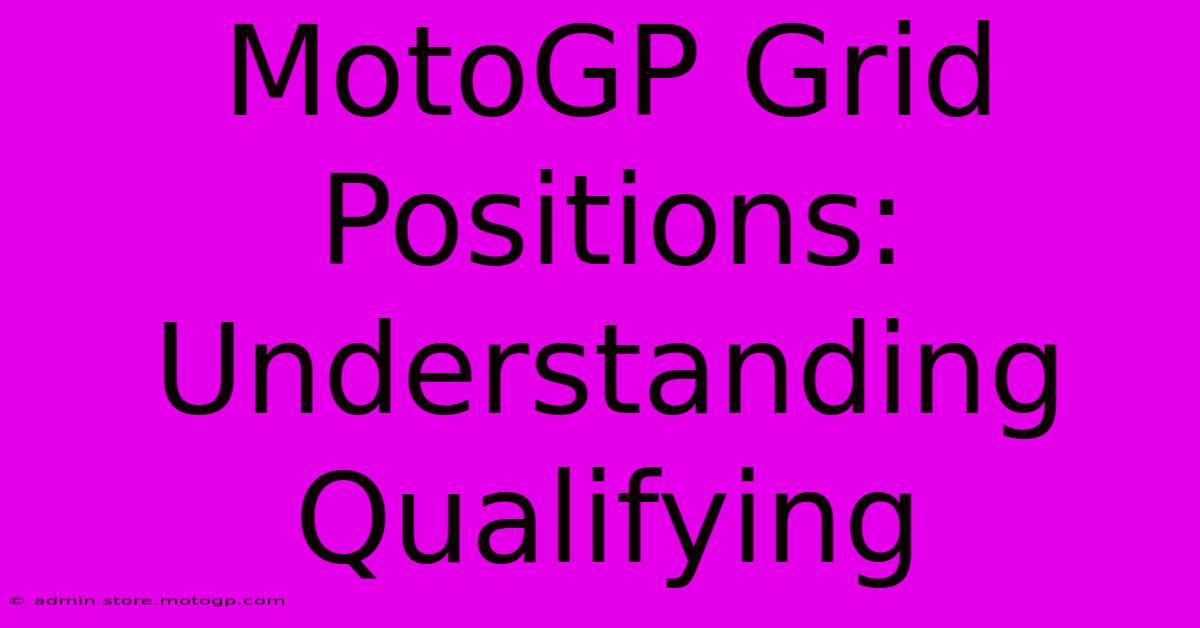MotoGP Grid Positions: Understanding Qualifying

Table of Contents
MotoGP Grid Positions: Understanding Qualifying
MotoGP racing is a spectacle of speed, skill, and strategy. But before the lights go out and the roar of the engines fills the air, there's a crucial phase that determines the starting positions: qualifying. Understanding how MotoGP qualifying works is key to appreciating the races themselves, and this guide will break it all down.
The Importance of Grid Position in MotoGP
A good starting position is arguably half the battle in MotoGP. Starting further up the grid significantly improves a rider's chances of a strong finish. Here's why:
- Clean Start: A better grid position minimizes the risk of being caught up in the chaotic first few corners, where crashes are most common.
- Track Position: Maintaining a leading position early on allows riders to control the race pace and dictates the strategy of their opponents.
- Slipstreaming: In MotoGP, slipstreaming is a crucial technique. A favorable grid position enables riders to benefit from the aerodynamic advantage of following another bike closely.
- Momentum: A good start builds confidence and momentum throughout the race.
The MotoGP Qualifying Format: A Step-by-Step Guide
The current MotoGP qualifying format is designed to be both exciting for spectators and a true test of a rider's skill and bike setup. It unfolds over several sessions:
FP1 and FP2 (Free Practice):
These sessions are crucial for setting the base. Riders utilize this time to test different bike setups, tire compounds, and race lines. While these sessions don't directly determine grid positions, the combined times from FP1 and FP2 determine which riders advance to Q2 directly.
Q1 (Qualifying 1):
The riders with the slowest combined times from FP1 and FP2 are relegated to Q1. This session is a high-stakes battle, with only the top two riders progressing to Q2. This session is intense, with riders pushing their bikes and themselves to the absolute limit. This is where the drama often begins!
Q2 (Qualifying 2):
Q2 involves the top ten riders from the combined FP1 and FP2 times plus the two riders who advanced from Q1. This is where the fight for pole position takes place – the ultimate goal for every rider. The fastest rider after this session claims pole position and the coveted spot on the front row of the grid.
Understanding the Qualifying Results and Grid
The results of Q2 determine the starting grid for the race. Pole position (the fastest time in Q2) earns the rider the most advantageous starting spot. The grid is arranged as follows:
- Row 1: Pole position, plus the two riders with the next fastest times.
- Row 2: The next three fastest riders.
- Row 3: The next three fastest riders.
- Row 4: The remaining riders, based on their qualifying times.
It's crucial to note that even a small difference in lap times can dramatically change grid positions. In MotoGP, the margins are incredibly tight, with thousandths of a second often separating several riders.
Factors Affecting Qualifying Performance
Several factors impact a rider's qualifying performance:
- Bike Setup: Optimizing the bike's setup for one lap qualifying run is crucial. This differs from the setup for race distance.
- Tire Choice: Choosing the right tire compound for qualifying is paramount. A softer tire may provide a faster lap time but might wear out quicker during the race.
- Track Conditions: Weather conditions such as temperature and humidity significantly influence grip levels and tire performance.
- Rider Skill: The rider's ability to push the limits of the bike and maintain consistency over a single flying lap is vital.
- Team Strategy: Strategic decisions regarding tire usage and fuel loads during practice impact qualifying performance.
Conclusion: The Crucial Role of Qualifying
The MotoGP qualifying format is a thrilling precursor to the race itself. Understanding its intricacies provides a deeper appreciation for the skill, strategy, and pressure involved in securing a favorable starting position. The battle for pole position is a microcosm of the larger race, showcasing the intensity and talent that defines MotoGP. Mastering this aspect of the sport is essential for both winning races and enjoying the spectacle to the fullest.

Thank you for visiting our website wich cover about MotoGP Grid Positions: Understanding Qualifying. We hope the information provided has been useful to you. Feel free to contact us if you have any questions or need further assistance. See you next time and dont miss to bookmark.
Featured Posts
-
Music Lovers Rejoice Circuit Of The Americas Concert Calendar
Feb 19, 2025
-
Moto Gp Top Speed The Quest For Glory
Feb 19, 2025
-
The Evolution Of Moto Gp Winglet Design
Feb 19, 2025
-
Unblock Geo Restricted Moto Gp Streams Watch Anywhere
Feb 19, 2025
-
The Technology Behind Moto Gp Helmet Visors
Feb 19, 2025
